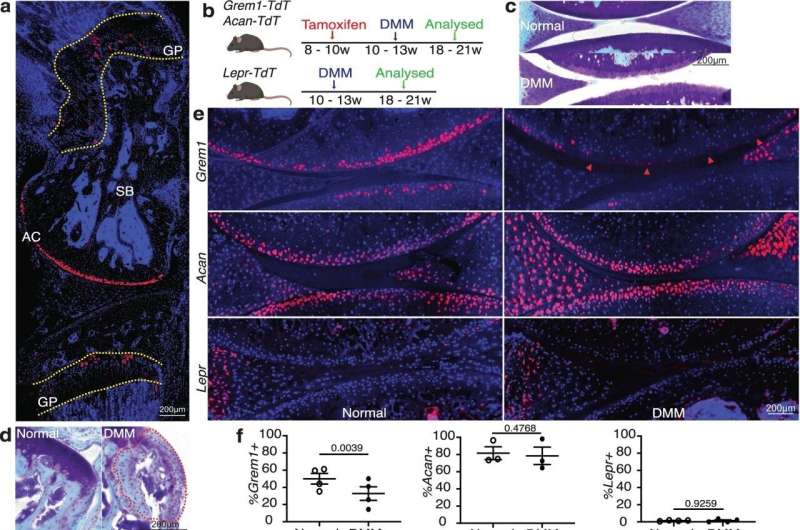This article has been reviewed according to Science X's editorial process and policies. Editors have highlighted the following attributes while ensuring the content's credibility:
fact-checked
trusted source
proofread
Gremlin 1 cells discovery offers hope to treat and reverse osteoarthritis

Current osteoarthritis treatment manages symptoms rather than addressing the underlying disease, but a new University of Adelaide study has shown the condition may be treatable and reversible. The research is published in the journal Nature Communications.
Osteoarthritis is the degeneration of cartilage and other tissues in joints and is the most common form of arthritis in Australia, with one in five people over the age of 45 having the condition.
It is a long-term and progressive condition which affects people's mobility and has historically had no cure. Its treatment cost the Australian health system an estimated $3.9 billion in 2019-20.
Often described as a 'wear and tear' condition, factors such as aging, obesity, injury and family history contribute to the progression of osteoarthritis.
University of Adelaide researchers discovered a novel population of stem cells—marked by the Gremlin 1 gene—responsible for the progression of osteoarthritis.
Treatment with fibroblast growth factor 18 (FGF18) stimulated the proliferation of Gremlin 1 cells in joint cartilage in mice, leading to significant recovery of cartilage thickness and reduced osteoarthritis.
Gremlin 1 cells present opportunities for cartilage regeneration and their discovery will have relevance to other forms of cartilage injury and disease, which are notoriously challenging to repair and treat.
It challenges the categorization of osteoarthritis as wear and tear.
"The findings of our study reimagine osteoarthritis not as a 'wear and tear' condition but as an active, and pharmaceutically reversible loss of critical articular cartilage stem cells," said the University of Adelaide's Dr. Jia Ng from the Adelaide Medical School, who co-led the study.
"With this new information, we are now able to explore pharmaceutical options to directly target the stem cell population that is responsible for the development of articular cartilage and progression of osteoarthritis."
While Dr. Ng describes current treatments for osteoarthritis as a "Band-Aid approach", this new understanding could lead to a pharmaceutical treatment that reverses osteoarthritis and helps to address health outcomes associated with the disease.
"Known comorbidities of osteoarthritis include heart, pulmonary, and kidney disease, mental and behavioral conditions, diabetes, and cancer," said Dr. Ng.
"Our study suggests that there may be new ways to treat the disease rather than just the symptoms, leading to better health outcomes and quality of life for people who suffer from osteoarthritis."
Though this discovery is limited to animal models, Dr. Ng said there are genetic similarities to human samples, and human trials are ongoing.
"We look forward to the outcome of these trials and to contribute to the better understanding of a pharmaceutical mechanism to treat osteoarthritis," she said.
Results of a five-year clinical trial study using FGF18, known clinically as Sprifermin, were published in 2021 with potential long-term clinical benefit and no safety concerns.
Phase 3 of the Sprifermin trial is ongoing, and researchers envision public access to this treatment soon.
More information: Jia Q. Ng et al, Loss of Grem1-lineage chondrogenic progenitor cells causes osteoarthritis, Nature Communications (2023). DOI: 10.1038/s41467-023-42199-1




















